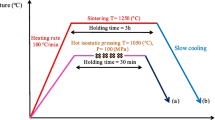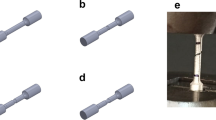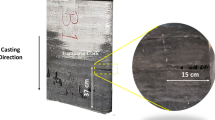Abstract
In this study, the microstructure of B319 casting alloys and effects of five different casting conditions on microstructure were studied. Multi-scale microstructure was quantified in terms of secondary dendrite arm spacing (SDAS), and Si particle size and aspect ratio. The effects of SDAS, Si aspect ratio and size on fatigue life were analyzed. The results indicate that the size and aspect ratio of Si particles are a function of SDAS which is dependent on cooling rate during solidification. The fatigue life decreases with SDAS increasing as SDAS is smaller than 30 μm while it increases with SDAS increasing as SDAS is larger than 60 μm. In addition, the fatigue life decreases with Si aspect ratio and size increasing at the same SDAS. Moreover, SDAS and Si particles have also influence on fatigue fracture, such as the area of cracks propagation region and the roughness of fatigue fracture. The cracks propagation area is smaller, and the fatigue fracture is similar to tensile fracture with larger SDAS. Besides, the longitudinal section of fatigue fracture is rougher with large SDAS and elongated Si particles.













Similar content being viewed by others
References
Ceschini L, Morri A, Morri A, Gamberini A, Messieri S. Correlation between ultimate tensile strength and solidification microstructure for the sand cast A357 aluminium alloy. Mater Des. 2009;30(10):4525.
Mo DF, He GQ, Hu ZF, Liu XS, Zhang WH. Effect of microstructural features on fatigue behavior in A319-T6 aluminum alloy. Mater Sci Eng A. 2010;527(15):3420.
Joseph S, Kumar S. A systematic investigation of fracture mechanisms in Al–Si based eutectic alloy—effect of Si modification. Mater Sci Eng A. 2013;588(12):111.
Ovono DO, Guillot I, Massinon D. Study on low-cycle fatigue behaviours of the aluminium cast alloys. J Alloys Compd. 2008;452(2):425.
Dobrzanski LA, Maniara R, Sokolowski JH. The effect of cooling rate on microstructure and mechanical properties of AC AlSi9Cu alloy. Arch Mater Sci Eng. 2007;28(2):105.
Wang QG, Apelian D, Lados DA. Fatigue behavior of A356/357 aluminum cast alloys. Part II-Effect of microstructural constituents. J Light Met. 2001;1(1):85.
Wang QG, Cáceres CH. Mg effects on the eutectic structure and tensile properties of Al–Si–Mg alloys. Mater Sci Forum. 1997;242:159.
Wang QG. Microstructural effects on the tensile and fracture behavior of aluminum casting alloys A356/357. Metall Mater Trans A. 2003;34(12):2887.
Zhang B, Poirier DR, Chen W. Microstructural effects on high-cycle fatigue-crack initiation in A356. 2 casting alloy. Metall Mater TransA. 1999;30(10):2659.
Islam MA, Farhat ZN. The influence of porosity and hot isostatic pressing treatment on wear characteristics of cast and P/M aluminum alloys. Wear. 2011;271(9):1594.
Xu Z, Wen W, Zhai T. Effects of pore position in depth on stress/strain concentration and fatigue crack initiation. Metall Mater Trans A. 2012;43(8):2763.
Ammar HR, Samuel AM, Samuel FH. Porosity and the fatigue behavior of hypoeutectic and hypereutectic aluminum–silicon casting alloys. Int J Fatigue. 2008;30(6):1024.
Arami H, Khalifehzadeh R, Akbari M, Khomamizadeh F. Microporosity control and thermal-fatigue resistance of A319 aluminum foundry alloy. Mater Sci Eng A. 2008;472(1):107.
Ammar HR, Samuel AM, Samuel FH. Effect of casting imperfections on the fatigue life of 319-F and A356-T6 Al–Si casting alloys. Mater Sci Eng A. 2008;473(1):65.
Wang QG, Apelian D, Lados DA. Fatigue behavior of A356-T6 aluminum cast alloys. Part I. Effect of casting defects. J Light Met. 2001;1(1):73.
El Sebaie O, Samuel AM, Samuel FH, Doty HW. The effects of mischmetal, cooling rate and heat treatment on the eutectic Si particle characteristics of A319. 1, A356. 2 and A413. 1 Al–Si casting alloys. Mater Sci Eng A. 2008;480(1):342.
Farhang Mehr F, Reilly C, Cockcroft S, Maijer D, MacKay R. Effect of chill cooling conditions on cooling rate, microstructure and casting/chill interfacial heat transfer coefficient for sand cast A319 alloy. Int J Cast Met Res. 2014;27(5):288.
Shabestari SG, Malekan M. Thermal analysis study of the effect of the cooling rate on the microstructure and solidification parameters of 319 aluminum alloy. Can Metall Q. 2005;44(3):305.
Firouzdor V, Rajabi M, Nejati E, Khomamizadeh F. Effect of microstructural constituents on the thermal fatigue life of A319 aluminum alloy. Mater Sci Eng A. 2007;454(16):528.
Mi GF, Liu XY, Zhu ZJ, Wang HW. Effects of chill casting processes on secondary dendrite arm spacing and densification of Al–Si–Mg alloy. Trans Nonferrous Met Soc China. 2007;17(5):1012.
Hosseini VA, Shabestari SG, Gholizadeh R. Study on the effect of cooling rate on the solidification parameters, microstructure, and mechanical properties of LM13 alloy using cooling curve thermal analysis technique. Mater Des. 2013;50(17):7.
Elmquist L, Dioszegi A. Relation between SDAS and eutectic cell size in grey iron. Int J Cast Met Res. 2010;23(4):240.
Shaha SK, Czerwinski F, Kasprzak W, Friedman J, Chen DL. Effect of solidification rate and loading mode on deformation behavior of cast Al–Si–Cu–Mg alloy with additions of transition metals. Mater Sci Eng A. 2015;636(1):361.
Lados DA. Fatigue crack growth mechanisms in Al–Si–Mg alloys. Surf Eng. 2004;20(6):416.
Acknowledgements
This study was financially supported by the National Natural Science Foundation of China (No. 50771073) and General Motors Funded Project (No. 1314).
Author information
Authors and Affiliations
Corresponding author
Rights and permissions
About this article
Cite this article
Shen, Y., Liu, XS., He, GQ. et al. Quantitative microstructure and fatigue life of B319 casting alloys. Rare Met. 36, 780–791 (2017). https://doi.org/10.1007/s12598-016-0863-8
Received:
Revised:
Accepted:
Published:
Issue Date:
DOI: https://doi.org/10.1007/s12598-016-0863-8




